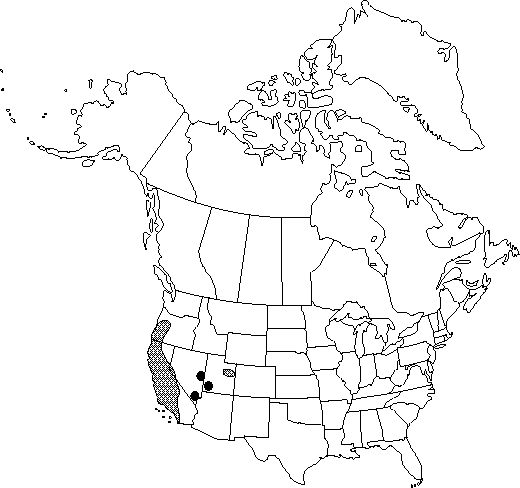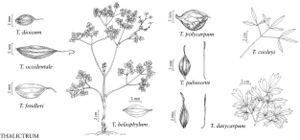Difference between revisions of "Thalictrum polycarpum"
Proc. Amer. Acad. Arts 14: 288. 1879.
FNA>Volume Importer |
FNA>Volume Importer |
||
| Line 24: | Line 24: | ||
}}<!-- | }}<!-- | ||
| − | --><span class="statement" id="st- | + | --><span class="statement" id="st-undefined" data-properties=""><b>Roots </b>fibrous. <b>Stems</b> erect, 6-18(-20) dm, glabrous. <b>Leaves</b> mostly cauline, petiolate. <b>Leaf</b> blade 3-4×-ternately compound; leaflets orbiculate to obovate, apically 3-cleft or 3-parted, divisions undivided or shallowly 3-lobed, 15-40 mm wide, lobes rounded or somewhat acute, surfaces glabrous or glandular. <b>Inflorescences</b> terminal, panicles, many flowered. <b>Flowers</b>: sepals whitish to purplish, elliptic to ovate or lanceolate, 2-4(-5) mm; filaments whitish to pinkish, 3-6 mm; anthers (1.4-)2-4 mm, distinctly apiculate. <b>Achenes</b> 10-15, spreading in globose heads, not reflexed, sessile or nearly so; stipe 0-0.6 mm; body nearly globose to obovoid to obliquely obovate, laterally compressed, somewhat inflated and papery, 4-7(-8) mm, glabrous to glandular, often with 1 or 2 primary veins on each side, veins sinuous, branched, anastomosing-reticulate; beak 2-4 mm.</span><!-- |
-->{{Treatment/Body | -->{{Treatment/Body | ||
| Line 30: | Line 30: | ||
|habitat=Streamsides and other moist places, forests, and open woodlands | |habitat=Streamsides and other moist places, forests, and open woodlands | ||
|elevation=600-3100 m | |elevation=600-3100 m | ||
| − | |distribution=Calif.;Nev.;Oreg.;Utah;Mexico (Baja California) | + | |distribution=Calif.;Nev.;Oreg.;Utah;Mexico (Baja California). |
|discussion=<p>Thalictrum polycarpum is the only species in sect. Heterogamia with anastomosing-reticulate veins on the achene.</p><!-- | |discussion=<p>Thalictrum polycarpum is the only species in sect. Heterogamia with anastomosing-reticulate veins on the achene.</p><!-- | ||
--><p>The stems and roots of Thalictrum polycarpum are considered poisonous when ingested by humans or cattle; Native Americans used this species medicinally as a wash for headaches, as an applications for sprains, and as a universal charm and panacea (D. E. Moerman 1986).</p> | --><p>The stems and roots of Thalictrum polycarpum are considered poisonous when ingested by humans or cattle; Native Americans used this species medicinally as a wash for headaches, as an applications for sprains, and as a universal charm and panacea (D. E. Moerman 1986).</p> | ||
| Line 51: | Line 51: | ||
|habitat=Streamsides and other moist places, forests, and open woodlands | |habitat=Streamsides and other moist places, forests, and open woodlands | ||
|elevation=600-3100 m | |elevation=600-3100 m | ||
| − | |distribution=Calif.;Nev.;Oreg.;Utah;Mexico (Baja California) | + | |distribution=Calif.;Nev.;Oreg.;Utah;Mexico (Baja California). |
|reference=None | |reference=None | ||
|publication title=Proc. Amer. Acad. Arts | |publication title=Proc. Amer. Acad. Arts | ||
|publication year=1879 | |publication year=1879 | ||
|special status=Selected by author to be illustrated | |special status=Selected by author to be illustrated | ||
| − | |source xml=https://jpend@bitbucket.org/aafc-mbb/fna- | + | |source xml=https://jpend@bitbucket.org/aafc-mbb/fna-data-curation.git/src/9216fc802291cd3df363fd52122300479582ede7/coarse_grained_fna_xml/V3/V3_372.xml |
|genus=Thalictrum | |genus=Thalictrum | ||
|section=Thalictrum sect. Heterogamia | |section=Thalictrum sect. Heterogamia | ||
|species=Thalictrum polycarpum | |species=Thalictrum polycarpum | ||
| − | |||
| − | |||
| − | |||
| − | |||
| − | |||
| − | |||
| − | |||
| − | |||
| − | |||
| − | |||
| − | |||
| − | |||
| − | |||
| − | |||
| − | |||
| − | |||
| − | |||
| − | |||
| − | |||
| − | |||
| − | |||
| − | |||
| − | |||
| − | |||
| − | |||
| − | |||
| − | |||
| − | |||
| − | |||
| − | |||
| − | |||
| − | |||
| − | |||
| − | |||
| − | |||
| − | |||
| − | |||
| − | |||
| − | |||
}}<!-- | }}<!-- | ||
-->[[Category:Treatment]][[Category:Thalictrum sect. Heterogamia]] | -->[[Category:Treatment]][[Category:Thalictrum sect. Heterogamia]] | ||
Revision as of 13:39, 27 July 2019
Roots fibrous. Stems erect, 6-18(-20) dm, glabrous. Leaves mostly cauline, petiolate. Leaf blade 3-4×-ternately compound; leaflets orbiculate to obovate, apically 3-cleft or 3-parted, divisions undivided or shallowly 3-lobed, 15-40 mm wide, lobes rounded or somewhat acute, surfaces glabrous or glandular. Inflorescences terminal, panicles, many flowered. Flowers: sepals whitish to purplish, elliptic to ovate or lanceolate, 2-4(-5) mm; filaments whitish to pinkish, 3-6 mm; anthers (1.4-)2-4 mm, distinctly apiculate. Achenes 10-15, spreading in globose heads, not reflexed, sessile or nearly so; stipe 0-0.6 mm; body nearly globose to obovoid to obliquely obovate, laterally compressed, somewhat inflated and papery, 4-7(-8) mm, glabrous to glandular, often with 1 or 2 primary veins on each side, veins sinuous, branched, anastomosing-reticulate; beak 2-4 mm.
Phenology: Flowering mid-late spring (Apr–Jun).
Habitat: Streamsides and other moist places, forests, and open woodlands
Elevation: 600-3100 m
Distribution

Calif., Nev., Oreg., Utah, Mexico (Baja California).
Discussion
Thalictrum polycarpum is the only species in sect. Heterogamia with anastomosing-reticulate veins on the achene.
The stems and roots of Thalictrum polycarpum are considered poisonous when ingested by humans or cattle; Native Americans used this species medicinally as a wash for headaches, as an applications for sprains, and as a universal charm and panacea (D. E. Moerman 1986).
Selected References
None.
